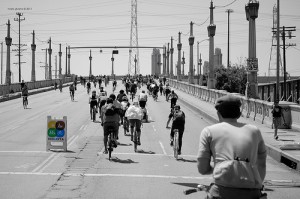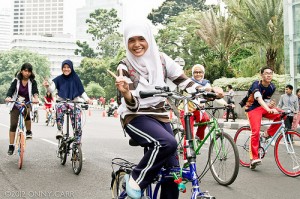 This is the game my older son and I played this weekend. He would bolt into a four-lane thoroughfare, and I would shout and jump around: “Get out of the street! It’s not safe! GetoutgetoutGETOUT!” Then I would dash into the street after him and we would laugh and laugh. And then he would pretend he was the grownup, and I was the kid, and he would yell at me. And we then laughed some more.
This is the game my older son and I played this weekend. He would bolt into a four-lane thoroughfare, and I would shout and jump around: “Get out of the street! It’s not safe! GetoutgetoutGETOUT!” Then I would dash into the street after him and we would laugh and laugh. And then he would pretend he was the grownup, and I was the kid, and he would yell at me. And we then laughed some more.
This probably isn’t the finest example of responsible parenting. But at least the street didn’t pose any dangers yesterday. Our town had its first-ever Open Streets day, where a 2.5-mile stretch of a main boulevard was closed to auto traffic. From 10 to 3, bikes and skateboards, strollers and running shoes, and even a few unicycles and a seven-seater “conference bike” ruled the roads.
People say the Open Streets movement started more than three decades ago in Bogotá, Colombia, when regular Ciclovía events would block off several main streets; the city still holds the event on Sundays and holidays, with close to 70 miles of open roads for the more than 2 million people who attend. North American cities have taken note, with Open Streets events running in big cities like New York, Los Angeles and Vancouver to smaller places including Carrboro, North Carolina and Paducah, Kentucky.
A survey of 600 people who strolled and rolled in San Francisco’s Sunday Streets found that 25 percent of those who attended more than one of the events said they’d increased their physical activity since their first Sunday. The researcher who led the study also reported that the attendees reflected San Francisco’s overall diversity—suggesting that these events might increase activity among communities that can suffer from greater risk of cardiovascular disease.
 No surveys have been published yet on about the 10,000 people who showed up to our local event this weekend. But everyone seemed to be smiling, whether on bike or on foot, playing air hockey or salsa dancing in the street. And there did seem to be just as many women as men—which is pretty critical for those who want to make cycling more engrained in their community. Women are often considered the “indicator species” for a city’s bike-friendliness; studies have found that women are less likely to use bike lanes on the street, instead heading for protected, off-street bike paths and quiet residential streets. (This is me: I stick to places easily accessible from the bike path or spots where I can safely practice my left turn.)
No surveys have been published yet on about the 10,000 people who showed up to our local event this weekend. But everyone seemed to be smiling, whether on bike or on foot, playing air hockey or salsa dancing in the street. And there did seem to be just as many women as men—which is pretty critical for those who want to make cycling more engrained in their community. Women are often considered the “indicator species” for a city’s bike-friendliness; studies have found that women are less likely to use bike lanes on the street, instead heading for protected, off-street bike paths and quiet residential streets. (This is me: I stick to places easily accessible from the bike path or spots where I can safely practice my left turn.)
And maybe it made an impression on other people, too. On the ride home, my younger son was drifting off to sleep when he said, “Are we going to dance in the street tomorrow?”
“No, buddy,” I said. “Not tomorrow.” And then, to head off a tantrum, I told him about a birthday party we were going to the next day.
He wouldn’t be distracted. “NO! I want to dance in the street TOMORROW!”
“Not tomorrow,” I said again. But someday soon, I hope.
**
Images from Flickr users work the angles (CicLAvia in Los Angeles) and killerturnip (ciclovia in Jakarta)
So much of our lives have been designed around the internal combustion engine, and where it can travel. It’s good to be able to shove it aside once in a while.